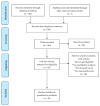Athletic Identity in Youth Athletes: A Systematic Review of the Literature
- PMID: 34299786
- PMCID: PMC8305814
- DOI: 10.3390/ijerph18147331
Athletic Identity in Youth Athletes: A Systematic Review of the Literature
Abstract
Athletic identity (AI), the degree of personal connection to sport, is well-described in adult research; however, this social trait has been less studied in younger age groups. This systematic review describes epidemiological characteristics of AI in youth athletes. PubMed, Embase and PsycInfo were searched to identify AI studies involving quantitative athlete identity outcomes and cohorts 22 years and younger. The search strategy was developed for each database using the Boolean method. PRISMA guidelines and the Appraisal Tool for Cross-Sectional Studies (AXIS) were utilized. Ten out of ninety-one studies met inclusion criteria. AI scores differed by race/ethnicity. Two studies found increased AI during adolescence compared to later in ones' training. Mental health-focused studies revealed higher AI levels protect against burnout, but in injured athletes, increased depression risk. Transitioning to a higher level of play during adolescence can correlate with stronger senses of AI. Further research should explore the concept of athletic identity saliency as one moves through an athletic career or training program and how thoughts of perceived success, professional progression, recruitment prospect or injury affect levels of athletic identity.
Keywords: adolescent athlete; athlete identity; athlete identity measurement scale.
Conflict of interest statement
The authors declare no conflict of interest.
Figures

Similar articles
-
Clinical Evaluation of the Concussed Athlete: A View From the Sideline.J Athl Train. 2017 Mar;52(3):236-244. doi: 10.4085/1062-6050-52.1.08. J Athl Train. 2017. PMID: 28387560 Free PMC article.
-
Enhancing athletic performance: the critical role of oral health in sports.Evid Based Dent. 2025 Jun;26(2):105-106. doi: 10.1038/s41432-025-01157-0. Epub 2025 May 13. Evid Based Dent. 2025. PMID: 40360821 Free PMC article.
-
Mental Health in Elite Athletes: A Systematic Review of Suicidal Behaviour as Compared to the General Population.Sports Med. 2024 Jun;54(6):1-18. doi: 10.1007/s40279-024-01998-2. Epub 2024 Feb 26. Sports Med. 2024. PMID: 38407749
-
The Relationship Between Training Load and Injury, Illness and Soreness: A Systematic and Literature Review.Sports Med. 2016 Jun;46(6):861-83. doi: 10.1007/s40279-015-0459-8. Sports Med. 2016. PMID: 26822969
-
Exploring the impact of athletic identity on gender role conflict and athlete injury fear avoidance in male English professional academy football players.Sci Med Footb. 2024 Aug;8(3):242-250. doi: 10.1080/24733938.2023.2224293. Epub 2023 Jun 18. Sci Med Footb. 2024. PMID: 37332231
Cited by
-
Emerging athletes' career transitions in professional sport: an existential multi-case perspective.Front Sports Act Living. 2024 Jul 4;6:1401848. doi: 10.3389/fspor.2024.1401848. eCollection 2024. Front Sports Act Living. 2024. PMID: 39027716 Free PMC article.
-
The relationship between passion and athlete identity in sport: the mediating and moderating role of dedication.BMC Psychol. 2024 Feb 15;12(1):76. doi: 10.1186/s40359-024-01565-4. BMC Psychol. 2024. PMID: 38360690 Free PMC article.
-
Identity and motivation of adolescent student-athletes in school and elite sport: an investigation of the relationship within- and cross-domains.Front Sports Act Living. 2025 Jul 22;7:1625068. doi: 10.3389/fspor.2025.1625068. eCollection 2025. Front Sports Act Living. 2025. PMID: 40765694 Free PMC article.
-
A badge, a part of my history and also a root: A longitudinal qualitative exploration of the social identity model of identity change in retired elite athletes.Br J Soc Psychol. 2025 Jul;64(3):e70005. doi: 10.1111/bjso.70005. Br J Soc Psychol. 2025. PMID: 40660610 Free PMC article.
-
The Athletic Identity Measurement Scale: A Systematic Review with Meta-Analysis from 1993 to 2021.Eur J Investig Health Psychol Educ. 2022 Sep 14;12(9):1391-1414. doi: 10.3390/ejihpe12090097. Eur J Investig Health Psychol Educ. 2022. PMID: 36135235 Free PMC article. Review.
References
-
- Greenwald A.G., Pratkanis A.R. The self. In: Wyer R.S. Jr., Srull T.K., editors. Handbook of Social Cognition. Volume 3. Lawrence Erlbaum Associates Publishers; Mahwah, NJ, USA: 1984. pp. 129–178.
-
- Kidwell J.S., Dunham R.M., Bacho R.A., Pastorino E., Portes P. Adolescent identity exploration: A test of Erikson’s theory of transitional crisis. Adolescence. 1995;30:785. - PubMed
-
- Stets J.E., Burke P.J. Identity Theory and Social Identity Theory. Soc. Psychol. Q. 2000;63:224. doi: 10.2307/2695870. - DOI
-
- Feezell R. Celebrated Athletes, Moral Exemplars, and Lusory Objects. J. Philos. Sport. 2005;32:20–35. doi: 10.1080/00948705.2005.9714668. - DOI
-
- Brewer B.W., van Raalte J.L., Linder D.E. Construct validity of the Athletic Identity Measurement Scale; Proceedings of the North American Society for the Psychology of Sport and Physical Activity Annual Conference; Monterey, CA, USA. 13–16 June 1991.
Publication types
MeSH terms
LinkOut - more resources
Full Text Sources
Medical
Miscellaneous

